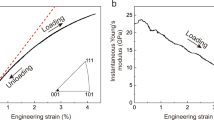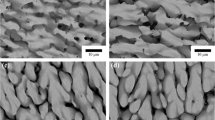Abstract
Materials undergoing reversible solid-to-solid martensitic phase transformations are desirable for applications in medical sensors and actuators1, eco-friendly refrigerators2,3 and energy conversion devices4. The ability to pass back and forth through the phase transformation many times without degradation of properties (termed ‘reversibility’) is critical for these applications. Materials tuned to satisfy a certain geometric compatibility condition have been shown2,5,6,7,8,9,10,11,12,13,14 to exhibit high reversibility, measured by low hysteresis and small migration of transformation temperature under cycling6,9,12,15. Recently, stronger compatibility conditions called the ‘cofactor conditions’5,15 have been proposed theoretically to achieve even better reversibility. Here we report the enhanced reversibility and unusual microstructure of the first martensitic material, Zn45Au30Cu25, that closely satisfies the cofactor conditions. We observe four striking properties of this material. (1) Despite a transformation strain of 8%, the transformation temperature shifts less than 0.5 °C after more than 16,000 thermal cycles. For comparison, the transformation temperature of the ubiquitous NiTi alloy shifts up to 20 °C in the first 20 cycles9,16. (2) The hysteresis remains approximately 2 °C during this cycling. For comparison, the hysteresis of the NiTi alloy is up to 70 °C (refs 9, 12). (3) The alloy exhibits an unusual riverine microstructure of martensite not seen in other martensites. (4) Unlike that of typical polycrystal martensites, its microstructure changes drastically in consecutive transformation cycles, whereas macroscopic properties such as transformation temperature and latent heat are nearly reproducible. These results promise a concrete strategy for seeking ultra-reliable martensitic materials.
This is a preview of subscription content, access via your institution
Access options
Subscribe to this journal
Receive 51 print issues and online access
$199.00 per year
only $3.90 per issue
Buy this article
- Purchase on Springer Link
- Instant access to full article PDF
Prices may be subject to local taxes which are calculated during checkout




Similar content being viewed by others
References
Walia, H., Brantley, W. A. & Gerstein, H. An initial investigation of the bending and torsional properties of Nitinol root canal files. J. Endod. 14, 346–351 (1988)
Liu, J., Gottschall, T., Skokov, K. P., Moore, J. D. & Gutfleisch, M. O. Giant magnetocaloric effect driven by structural transitions. Nature Mater. 11, 620–626 (2012)
Moya, X. et al. Giant electrocaloric strength in single-crystal BaTiO3 . Adv. Mater. 25, 1360–1365 (2013)
Srivastava, V., Song, Y., Bhatti, K. & James, R. D. The direct conversion of heat to electricity using multiferroic alloys. Adv. Energy Mater. 1, 97–104 (2011)
James, R. D. & Zhang, Z. In Magnetism and Structure in Functional Materials (eds Planes, A., Mañosa, L. & Saxena, A. ) 159–175 (Springer, 2005)
Cui, J. et al. Combinatorial search of thermoelastic shape-memory alloys with extremely small hysteresis width. Nature Mater. 5, 286–290 (2006)
Zhang, Z., James, R. D. & Müller, S. Energy barriers and hysteresis in martensitic phase transformations. Acta Mater. 57, 4332–4352 (2009)
Pitteri, M. & Zanzotto, G. Continuum Models for Phase Transitions and Twinning in Crystals (Chapman and Hall/CRC, 2010)
Zarnetta, R. et al. Identification of quaternary shape memory alloys with near-zero thermal hysteresis and unprecedented functional stability. Adv. Funct. Mater. 20, 1917–1923 (2010)
Delville, R. et al. Transmission electron microscopy study of phase compatibility in low hysteresis shape memory alloys. Phil. Mag. 90, 177–195 (2010)
Srivastava, V., Chen, X. & James, R. D. Hysteresis and unusual magnetic properties in the singular heusler alloy Ni45Co5Mn40Sn10 . Appl. Phys. Lett. 97, 014101 (2010)
Bechtold, C., Chluba, C., de Miranda, R. L. & Quandt, E. High cyclic stability of the elastocaloric effect in sputtered TiNiCu shape memory films. Appl. Phys. Lett. 101, 091903 (2012)
Ball, J. M. & James, R. D. Fine phase mixtures as minimizers of energy. Arch. Ration. Mech. Anal. 100, 13–52 (1987)
Bhattacharya, K. Microstructure of Martensite: Why It Forms and How It Gives Rise to the Shape-Memory Effect (Oxford Univ. Press, 2003)
Chen, X., Srivastava, V., Dabade, V. & James, R. D. Study of the cofactor conditions: conditions of supercompatibility between phases. J. Mech. Phys. Solids http://dx.doi.org/10.1016/j.jmps.2013.08.004 (2013)
Tadaki, T., Nakata, Y. & Shimizu, K. Thermal cycling effects in an aged Ni-rich Ti-Ni shape memory alloy. Trans. Jpn Inst. Metals 28, 883–890 (1987)
Mott, N. F. Metal-Insulator Transitions Ch. 5 (Taylor & Francis, 1990)
Eggeler, G., Hornbogen, E., Yawny, A., Heckmann, A. & Wagner, M. Structural and functional fatigue of NiTi shape memory alloys. Mater. Sci. Eng. A 378, 24–33 (2004)
Norfleet, D. M. et al. Transformation-induced plasticity during pseudoelastic deformation in Ni-Ti microcrystals. Acta Mater. 57, 3549–3561 (2009)
Wechsler, M. S., Lieberman, D. S. & Read, T. A. On the theory of the formation of martensite. J. Metall./Trans. AIME 197, 1503–1515 (1953)
Bowles, J. S. & Mackenzie, J. K. The crystallography of martensite transformations I/II. Acta Metall. 2, 129–137 (1954)
Meethong, N., Huang, H.-Y., Speakman, S., Carter, W. & Chiang, Y.-M. Strain accommodation during phase transformations in olivine-based cathodes as a materials selection criterion for high-power rechargeable batteries. Adv. Funct. Mater. 17, 1115–1123 (2007)
Louie, M. W., Kislitsyn, M., Bhattacharya, K. & Haile, S. M. Phase transformation and hysteresis behavior in Cs1-xRbxH2PO4 . Solid State Ion. 181, 173–179 (2010)
Bhattacharya, K. & Kohn, R. V. Symmetry, texture and the recoverable strain of shape-memory poly-crystals. Acta Mater. 44, 529–542 (1996)
Tadaki, T., Okazaki, H., Yoshiyuki, N. & Shimizu, K. Atomic configuration determined by ALCHEMI and X-ray diffraction of the L21 type parent phase in a Cu-Au-Zn shape memory alloy. Mater. Trans. JIM 31, 935–940 (1990)
Tadaki, T., Okazaki, H., Yoshiyuki, N. & Shimizu, K. Atomic configuration determined by ALCHEMI and X-ray diffraction of a stabilized M18R martensite in a β phase Cu-Au-Zn alloy. Mater. Trans. JIM 31, 941–947 (1990)
Amengual, A. et al. Systematic study of the martensitic transformation in a Cu-Zn-Al alloy. Reversibility versus irreversibility via acoustic emission. Thermochim. Acta 116, 195–208 (1987)
Sethna, J. P. et al. Hysteresis and hierarchies: dynamics of disorder-driven first-order phase transformations. Phys. Rev. Lett. 70, 3347–3350 (1993)
Sethna, J. P., Dahmen, K. A. & Myers, C. R. Crackling noise. Nature 410, 242–250 (2001)
Vives, E., Soto-Parra, D., Mañosa, L., Romero, R. & Planes, A. Imaging the dynamics of martensitic transitions using acoustic emission. Phys. Rev. B 84, 060101 (2011)
Acknowledgements
We acknowledge the financial support of MURI projects FA9550-12-1-0458 (administered by AFOSR) and W911NF-07-1-0410 (administered by ARO). This research also benefited from the support of NSF-PIRE grant number OISE-0967140. Y.S. thanks the Graduate School of the University of Minnesota for support through a Doctoral Dissertation Fellowship.
Author information
Authors and Affiliations
Contributions
R.D.J. is the Principal Investigator and initiated and supervised the work. Y.S. designed the thermal cycling apparatus and carried out optical and calorimetric experiments. X.C. performed X-ray diffraction measurements and theoretical calculations of microstructure. V.D. synthesized all the specimens used in the study. T.W.S. provided expertise in the experimental design and data acquisition. All authors discussed the results and approved the manuscript. Y.S., X.C. and R.D.J. interpreted the data and wrote the manuscript.
Corresponding author
Ethics declarations
Competing interests
The authors declare no competing financial interests.
Supplementary information
Supplementary Information
This file contains 2 Supplementary Discussions, Supplementary Methods, Supplementary Figures 1-4 and Supplementary Tables 1-2. (PDF 2785 kb)
Non-repeating microstructure of Zn45Au30Cu25 in consecutive cycles
This video records the evolution of surface morphology in Zn45Au30Cu25 in several consecutive phase transformation cycles beginning with the 65th cycle. The horizontal span of the screen is about 1 mm. The replay is in approximately real time. The temperature range of oscillation is set between -32 and -42 °C on the controller, but the real temperature range is slightly wider because of overshooting upon heating and cooling. We can see that this sample exhibits completely different microstructure in consecutive cycles, which is different from common polycrystal martensitic materials. In addition, unusual riverine microstructures and single variant wide bands are observed, indicating high degree of compatibility between martensite and austenite during the microstructure development. (MOV 26133 kb)
Rights and permissions
About this article
Cite this article
Song, Y., Chen, X., Dabade, V. et al. Enhanced reversibility and unusual microstructure of a phase-transforming material. Nature 502, 85–88 (2013). https://doi.org/10.1038/nature12532
Received:
Accepted:
Published:
Issue Date:
DOI: https://doi.org/10.1038/nature12532
This article is cited by
-
Zero-dimensionality of a scaled-down VO2 metal-insulator transition via high-resolution electrostatic gating
NPG Asia Materials (2023)
-
Ericksen-Landau Modular Strain Energies for Reconstructive Phase Transformations in 2D Crystals
Journal of Elasticity (2023)
-
First-principles calculations of Ni-(Co)-Mn-Cu-Ti all-d-metal Heusler alloy on martensitic transformation, mechanical and magnetic properties
International Journal of Minerals, Metallurgy and Materials (2023)
-
Materials, physics and systems for multicaloric cooling
Nature Reviews Materials (2022)
-
Ferroelastic oligocrystalline microwire with unprecedented high-temperature superelastic and shape memory effects
NPG Asia Materials (2022)
Comments
By submitting a comment you agree to abide by our Terms and Community Guidelines. If you find something abusive or that does not comply with our terms or guidelines please flag it as inappropriate.



